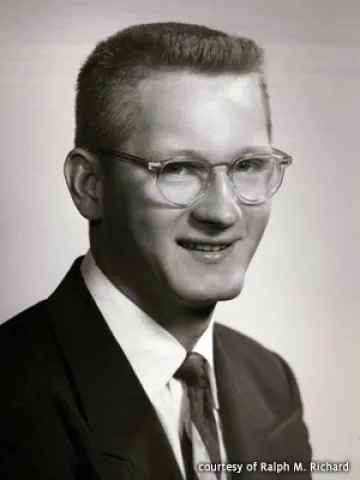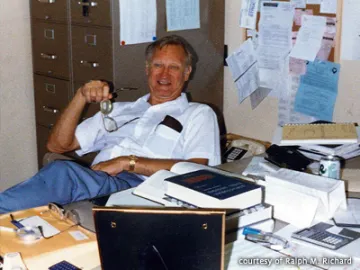Etendue: Ralph M. Richard

Welcome to Etendue, featuring interesting and accomplished individuals known for their leadership and contributions both with their careers and the College of Optical Sciences, in their own words. (For a similar view on the college’s best and brightest – our students – please check out Another Wavelength among our Students in the Spotlight.)
This month, we hear from Ralph M. Richard, Ph.D., Research Professor Emeritus of Optical Sciences.
Where are you from?
I was born and raised on our family farm in northern Indiana – the tenth child of 13. With that many we almost loaded the school bus! Work on the farm was seven days a week. My morning and evening chores included running the milking machines for 40 cows. Cows, you know, produce more than just milk. Summer school "vacation" at our country school was five months – May to September – when most of planting and harvesting of the crops were done. I was driving a tractor at the age of eight and repairing and welding farm equipment, some of which I busted, at 12.
From high school, I entered the University of Notre Dame quite unprepared. During the first week on campus, I learned from my two roommates, who had graduated from prestigious college-prep high schools, the rudiments of trigonometry, logarithms, and how to use a slide rule.

Graduation from Notre Dame, 1952.
Describe your early career.
After graduation, I Joined McDonnell Aircraft in St. Louis as a structural engineer and also started graduate school at Washington University but got drafted during the Korean War.
I spent two years in the Army as a special agent in the Counter Intelligence Corps and ran security investigations in the northeast area of Indiana. To my knowledge there has not been a single communist found in that area since I left the army.
I returned to Washington University as an instructor and completed my M.S. I then resumed employment at McDonnell Aircraft and wrote their first Finite Element Analysis (FEA) program.
I was accepted at Purdue University for my doctorate, received in 1961. I was then hired by Notre Dame as a faculty member for three years. In 1964, I joined the University of Arizona College of Engineering as faculty in Civil Engineering and Engineering Mechanics.

On the farm in Indiana, 1980.
How did the College of Optical Sciences become a part of your career interest?
Teaching seminar in Saudi Arabia, 1986.
As a consultant to General Dynamics from 1966 to 1972, I was involved in writing, instructing, and applying the FEA method to the design of the F111 and F16 aircraft. In 1967 and 1968 I used FEA in the structural design of the Myall 4-m telescope.
This was my first experience of the design of optical structures.
In 1968, Dr. Aden Meinel offered me a joint faculty appointment with the College of Optical Sciences (OSC). In this role, my colleague, Allan Malvick, and I designed the mirror support systems for the Whipple Multi-mirror telescope.

Teaching seminar in Saudi Arabia, 1986.
In the 1970s Professor Robert Shannon had a DARPA contract to develop an active mirror support system. Our unique design included both piston and tip-tilt positioning.
The research in the mechanical design of optical instruments has led to the formal discipline of optomechanics in our college with support from the college of engineering.
How do you stay involved in this field and the College?
Hard at work in my OSC office, 1987.
After "retiring," I have written five patents and papers on the design of earthquake resistant structural building frames. This work was motivated by the damages caused by California Northridge earthquake of 1994.
As a Professor Emeritus of the College, I still remain semi-active pro bono in the large optics laboratory.
[Editor’s Note: Drs. Ralph and Sue Richard have demonstrated noteworthy interest in student success for both the College and the University. They are also among the generous donors to the College’s graduate student FoTO scholarship program].

Hard at work in my OSC office, 1987.
